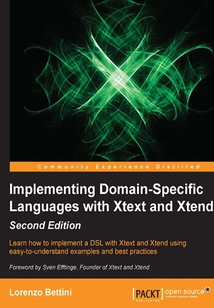首頁 > 計算機網絡 >
操作系統
> Implementing Domain-Specific Languages with Xtext and Xtend(Second Edition)最新章節目錄
舉報 

會員
Implementing Domain-Specific Languages with Xtext and Xtend(Second Edition)
最新章節:
Index
Thisbookistargetedatprogrammersanddeveloperswhowanttocreateadomain-specificlanguagewithXtext.TheyshouldhaveabasicfamiliaritywithEclipseanditsfunctionality.PreviousexperiencewithcompilerimplementationcanbehelpfulbutisnotnecessarysincethisbookwillexplainallthedevelopmentstagesofaDSL.
目錄(114章)
倒序
- 封面
- 版權頁
- Credits
- Foreword
- About the Author
- Acknowledgments
- About the Reviewer
- www.PacktPub.com
- eBooks discount offers and more
- Preface
- What this book covers
- What you need for this book
- Who this book is for
- Conventions
- Reader feedback
- Customer support
- Preface to the second edition
- Chapter 1. Implementing a DSL
- Domain-Specific Languages
- Implementing a DSL
- IDE integration
- Enter Xtext
- The aim of this book
- Summary
- Chapter 2. Creating Your First Xtext Language
- A DSL for entities
- The Xtext generator
- The Eclipse Modeling Framework (EMF)
- Improvements to the DSL
- Summary
- Chapter 3. Working with the Xtend Programming Language
- An introduction to Xtend
- Xtend – a better Java with less "noise"
- Additional operators
- Summary
- Chapter 4. Validation
- Validation in Xtext
- Quickfixes
- Summary
- Chapter 5. Code Generation
- Introduction to code generation
- Writing a code generator in Xtend
- Integration with the Eclipse build mechanism
- Standalone command-line compiler
- Summary
- Chapter 6. Customizing Xtext Components
- Dependency injection
- Google Guice in Xtext
- Customizations of IDE concepts
- Custom formatting
- Other customizations
- Summary
- Chapter 7. Testing
- Introduction to testing
- JUnit 4
- The ISetup interface
- Implementing tests for your DSL
- Test suite
- Testing the UI
- Testing and modularity
- Clean code
- Summary
- Chapter 8. An Expression Language
- The Expressions DSL
- The grammar for the Expressions DSL
- Left recursive grammars
- Forward references
- Typing expressions
- Writing an interpreter
- Optimizations and fine tuning
- Summary
- Chapter 9. Type Checking
- SmallJava
- First validation rules
- Type checking
- Improving the UI
- Summary
- Chapter 10. Scoping
- Cross-reference resolution in Xtext
- Custom scoping
- Global scoping
- Providing a library
- Classes of the same package
- Dealing with super
- What to put in the index?
- Additional automatic features
- Providing a project wizard
- Summary
- Chapter 11. Continuous Integration
- Eclipse features and p2 repositories
- Release engineering
- Introduction to Maven/Tycho
- Using the Xtext project wizard
- Continuous Integration systems
- Your DSL editor on the Web
- IntelliJ and Gradle
- Pitfalls with Maven/Tycho
- Concluding remarks
- Summary
- Chapter 12. Xbase
- Introduction to Xbase
- The Expressions DSL with Xbase
- The Entities DSL with Xbase
- Additional Xbase features
- Summary
- Chapter 13. Advanced Topics
- Creating an Xtext project from an Ecore model
- Switching to an imported Ecore model
- Xcore
- Extending Xbase
- Summary
- Chapter 14. Conclusions
- Appendix A. Bibliography
- Index 更新時間:2021-07-14 10:06:56
推薦閱讀
- BPEL and Java Cookbook
- 精解Windows 8
- Ganglia系統監控
- 計算機系統開發與優化實戰
- Windows Phone 8 Application Development Essentials
- STM32庫開發實戰指南:基于STM32F4
- Linux使用和管理指南:從云原生到可觀測性
- AutoCAD 2014中文版從入門到精通
- Windows 7應用入門與技巧
- Advanced TypeScript Programming Projects
- iOS 8開發指南
- 鴻蒙操作系統設計原理與架構
- 統信UOS應用開發進階教程
- Docker容器技術與應用
- Linux內核分析及應用
- Learn OpenShift
- Azure Serverless Computing Cookbook
- 構建高可用Linux服務器
- 計算機操作系統實用教程
- 計算機應用基礎:Windows 7+Office 2010(下冊)
- OpenStack從零開始學
- Linux Device Driver Development Cookbook
- Responsive Web Design with HTML5 and CSS
- 嵌入式Linux系統實訓教程
- 深度學習在動態媒體中的應用與實踐
- Kali Linux高級滲透測試(原書第2版)
- Windows PowerShell實戰指南(第3版)
- INSTANT jQuery Drag-and-Drop Grids How-to
- 電腦辦公從入門到精通(Windows 7+Office 2013版)
- 生活要有新7象:超人氣Windows7漫畫寶典

